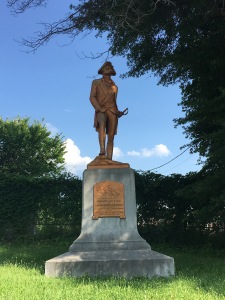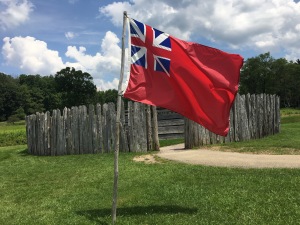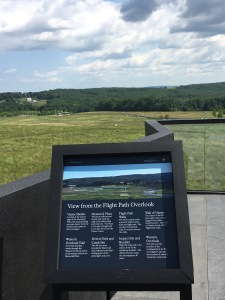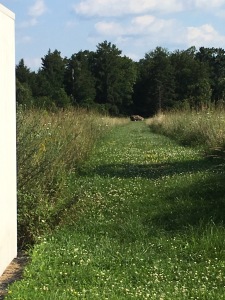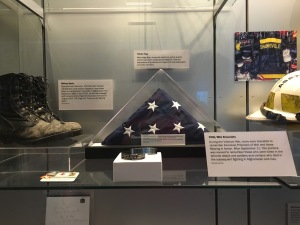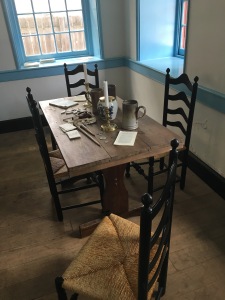Just wanted to give everyone a heads up that I am dividing this site into two. Legacy Hunting will be my site for foreign travels: Canada, Europe, Cambodia, and anywhere else I decide to wander. Local Legacy Hunting (locallegacyhunting.wordpress.com) will now be my site for US trips. I figured that would help organize things a bit better. So, if you want to keep track of me in the US and not just internationally, make sure to follow there too. I’m off to Cambodia on Tuesday! Blessings on all your travels and as the Irish say, “May the Road Rise up to Meet You!” Thanks!
March 30, 2018
John Denver, Laura Ingalls Wilder, and Rainy Days in and around Branson, Missouri
Posted by amybrailey under Branson, Export, Laura Ingalls Wilder, Little House on the Prairie, Missouri, Photography, Travel | Tags: Almanzo Wilder, Branson, Charles Ingalls, History, James Garrett, John Denver, Laura Ingalls Wilder, Missouri, Photography, Travel |Leave a Comment

Stormy Point Village
I haven’t posted this Spring Break because we knew it would be rainy the whole week in Branson, Missouri, so we mostly brought projects to work on. But, we did have see a few things that are definitely worth sharing.
On Wednesday (3/28/18), we went to hear James Garrett in his tribute to John Denver. Whether you’re like me and grew up playing John Denver songs on the piano or you have never heard of him before, this is an incredible show and has been voted the best morning show for the past 6 years! In addition to James (whose music you can check out here,) the band also included Randy Plummer with gospel songs, Shannon Comer on percussion, and Shawn Pittman playing a mean violin and hammered dulcimer. Additionally, James shares about not only his friendship with John Denver and some funny anecdotes, but also his experience growing up in 18 different homes as a foster kid, leading him to start the foundation Jacob’s House at Thunder Ranch to provide a safe place for foster kids. Truly an amazing heart born out of first hand experience.
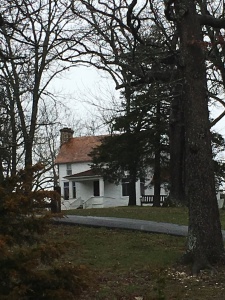
The Wilders’ last home
Then, yesterday (3/29/18), we headed over to Mansfield, Missouri, to visit the Laura Ingalls Wilder and Rose Wilder Lane Museum and Home. Though still a rainy day, it was a great experience. The main home is entirely filled with originals, as if Laura just stepped out. In fact, everything but the kitchen floor, the curtains, and the bedspreads are original. In many places, the wallpaper is the original pattern, but has been remade.
One cool feature of the house is that Laura designed it and Almanzo built it. It’s also amazing to realize how short they actually were—Laura stood only 4’11” and Almanzo was somewhere around 5’4”, so a small couple. We took the tour in the order the home was built.
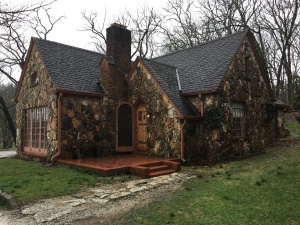
The Rock House
There were so many amazing original pieces including the Christmas clock, which Almanzo had traded hay to get. This is the same one mentioned in The First Four Years. There are also a number of pieces of furniture Almanzo made from lamps to tables. And the storage he built in is unparalleled! (Though perhaps that was Laura’s design.)
The rock house was purchased by Rose who was the second most demanded writer in America before Laura even started writing. She bought it from the Sears Roebuck catalog, which is interesting. Though the house is much more sparsely furnished (the Wilders only lived in it for 7 years while Rose lived in their house—after that, they rented it out), it was in this house that Laura began writing the Little House books.
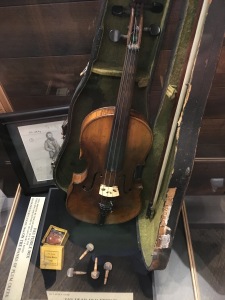
Pa’s fiddle
Before we left, we headed to the museum, which contains many other family pieces—most notably Pa’s fiddle, Laura’s wedding dress, and original manuscripts. Definitely an incredible museum.
We ended off today (3/30/18) with a drive on our first sunny day of the week. We drove out to the steamboat and then walked around in the Sight and Sound theatre which is performing Samson currently.

Sight and Sound Theatre entrance
All in all, this has been a restful trip with some neat sights to see.
December 30, 2017
Carnage in Franklin: Exploring the Carter and Lotz Houses and the Carter Plantation
Posted by amybrailey under Battlefield, Civil War, Export, Photography, Tennessee, Travel | Tags: Battle of Franklin, History, John Bell Hood, Photography, Travel, William Tecumseh Sherman |Leave a Comment

The Carter House
Having been drawn to Franklin, Tennessee, since reading The Widow of the South, we came to Nashville with plans of spending time in Franklin. Today (12/26/17), we made a power trip to three main sites.
We started chronologically at the Carter house. We planned to arrive around opening time (9:00 AM) to explore a bit before the 10:00 Slavery tour (held on Tuesdays at the Carter House and Thursdays at Carnton). Since the tour was just my mom and I, and I had a good grasp on the legislation involving slavery, we got a unique experience. Christy shared with us some of the things she felt were the most interesting in her vast research on slavery and specifically on the slaves at the Carter House.
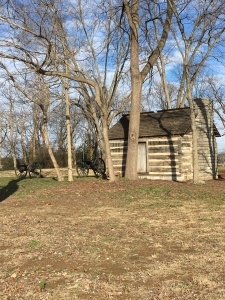
Slave Cabin moved in from another plantation in the area
She started with slavery’s origin in Africa. While I knew there were huge losses during the Middle Passage, I wasn’t aware just how many lost their lives. 12.3 million slaves left Africa on slave ships and only 10.7 million survived. That’s roughly 17%. Another surprising statistic was that only 450,000 came to America–less than 4%. The rest were sent to the Caribbean or South America where they were often worked to death. One thing that made American slavery unique was allowing some slaves to stay together in family units–something Carter did.
While Christy rightfully stressed that even the best slavery was still slavery, the Carters seemed to be one of the best. They worked alongside their slaves in the field and protected their slaves with them in the day of the Battle of Franklin. Their 28 slaves were not only able to live as family units (and were listed as family units instead of most valuable to least valuable), but several were also left 200 acres of land a piece in Carter’s will. The families (both names Carters as the slaves took the Carter’s name) have also remained close through the generations after slavery. We got to see a picture, probably from the 1890’s) of the mom’s and babies of both the black and white Carters standing together–just two moms and their boys who grew up and stayed best friends all their lives. It was neat to see Rev. Dr. Martin Luther King’s “sons of former slaves and the sons of former slave owners sit down together at the table of brotherhood” before Martin Luther King was even on the scene.
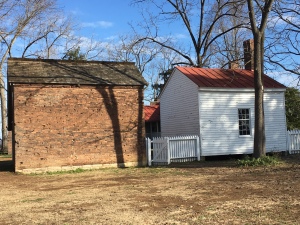
Visible damage in both the smoke house and the field office
After the Slavery Tour, we stayed for the traditional house tour. Adam did an incredible job of explaining the carnage of November 30, 1864.
He started with a conflict between John Bell Hood (Confederate) and William Tecumseh Sherman (Federal). The two had been engaged in conflict before Sherman began his famous March to the Sea. When Sherman set out, Hood tried unsuccessfully to lure him back into the area, but Sherman continued on. Hood then decided to take Nashville, both for a morale boost and supplies. Sherman sent Schofield to cut Hood off, leading the two to embark on a race to Nashville, where only around 8,000 federals were guarding the area.
Hood and Schofield, both with around 30,000 men, each outmaneuver the other. Finally, Hood gets around Schofield. He has Schofield trapped, and both sides know it. Hood gives strict orders to block the road, and not leave any way for Schofield to retreat. He then prepares to accept Schofield’s surrender in the morning. But, in the fiasco of the century, the order is dropped, and the Confederates bed down for the night on either side of a wide open road. Schofield is somehow able to march his men right through the sleeping Confederates, a testimony to either his stealth or their exhaustion.
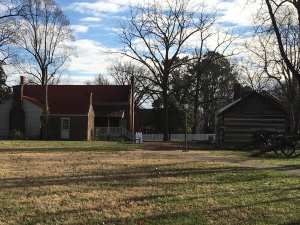
View of the Carter Property
Around 4 AM, Federal Brigidier General Jacob Cox knocks on the door of the Carter house, looking for a place to rest for a few hours–his own men are as exhausted as Hood’s. Fully believing his men will be able to retreat across the river, he tells Fountain Branch Carter there will be no battle–the men are just exhausted and need a place to rest. Fountain Branch asks about leaving, but Cox recommends staying, as he can’t guarantee the safety of their house or belongings if he leaves. However, when Cox’s scout wakes him up around 4:30 AM to let him know the bridges are badly damaged and none of the promised pontoon boats have arrived, leaving them trapped, things change. Cox awakens his men, sends engineers to repair the broken bridges, and orders the rest to entrench. They know Hood will wake up, discover they’ve left, and be hot on their heels, madder than a hornet. They build lines of defense: the first, a two mile trench from river bank to river bank with the city of Franklin behind. They then build a secondary line of trenches near the Carter house. The third line (advanced guard) is about 1/2 mile south. Now, they wait.
Wagner (Federal) had ordered Opdycke and two other brigades to utilize their men for an advanced line of observation. Opdycke, however, argues with this command and Wagner finally tells him to “fight wherever you d–n well please!” Obdycke takes his men back to the Carter house–a move that will prove providential for the Union (and bring recognition to Opdycke). Opdycke’s men who left the advanced guard go in to rest.
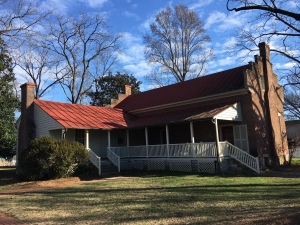
View showing the distance between the cellar (right) and the front door (left)
As expected, Hood’s men start arriving around 1 (They will be seen by Mrs. McGavock over at Carnton as Franklin is mostly fields with only 750 actual residents.) Schofield expects Hood to see the entrenched Yankees, observe the lateness of the day, and wait–hopefully allowing the bridges to be repaired or the boats to arrive. Yet, at 4:00 PM, as it’s beginning to grow dark on Winstead Hill, Hood’s men step off.
Hood’s battle plan is brilliant and initially effective. Attack the advance guard, and push them back to punch a hole in the middle of the Union line. Then, pour his men through the gap to flank the Union. Initially, his plan works. The Union advance guard makes a full speed retreat. The first line of defense can’t fire because their own men are coming between them and the Confederates, who punch a hole straight through. Surprisingly, the flanks hold. The weak links–rookies from Ohio and Missouri, who were put in the second line to keep them from screwing things up, are now fighting like the devil. Opdyke’s men, now rested, hear the commotion and come charging in without orders. Running to the fray, they charge straight up to confront the Confederates.
What follows is hours of the most brutal hand to hand combat in the war. While the family, their slaves, and their neighbors the Lotz family crouch in their basement, soldiers are cut down with grape shot (canister), bludgeoned with guns, bayoneted, or bit (yes, actually bit.) Men used everything they could get their hands on to hurt each other, and bodies piled up 6-7 deep or were used as human shields. In some places, soldiers couldn’t even fall to die because the number of dead around them held them up.
After fighting finally died down around 9:00 PM, the sun rose to 10,000 casualties–7,500 of whom were Confederates. There were six generals dead and another 7 captured, making this a significant loss. One out of every four soldiers were killed in the 5 hours of fighting. Carter described having to shovel a path from the cellar to his front door through the bodies (57 of them) and carrying a bucket for brains.
The bridges were finally finished, and Schofield’s regiment would cross the river to reinforce Nashville, where a mere two weeks later, Hood would try another assault which also fails, and he is chased back through Franklin–a town that will be indeliably changed.
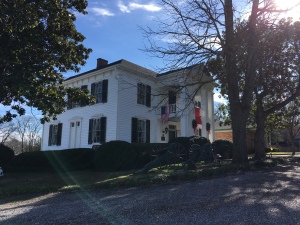
The Lotz House
Finishing the battle tour, we rushed over to the Lotz House where we had the privilege to take a tour with Thomas Cartwright–leading expert on the Battle of Franklin. He shared much of what we heard at the Carter House, but understandably focused more on the Lotz family–particularly the daughter Matilda Lotz who became an internationally famous painter. He explained the Lotz’s held their daughter’s birthday party the night before the battle, oblivious of events about to unfold. The next day, the area is overrun by federals, and Matilda’s pet calf is shot in front of her. Tom attributes this experience to the fact that Matilda will make her international reputation painting with kind faces.
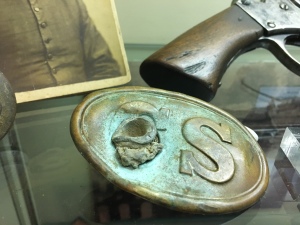
Artifacts from the Lotz House–I think there had to be a good story here
In addition to the horrors of losing a pet, Tom asks us to imagine being Mr. Lotz trying to rush his wife and three children 150 paces over to the Carter cellar. It must have been nerve-wracking! Tom also shows places where blood stains the floor of the Lotz house and cannon balls damaged both floor and ceiling–in fact, so much of the house was destroyed that it took Lotz four years to repair a house it’d taken him only three years to build. Tom also points out that Lotz, a master carpenter, was obviously in a hurry to get his family out of the cellar, as there are hammer marks in the repaired areas of the floor. Another disturbing fact is that the nails in the floor are horseshoe nails. Knowing that six horses were left dead in the Lotz yard, and how many nails per horse shoe, it is interesting to see the same number of horseshoe nails holding together the patches in the floor. Another indication of how desperate the area must have been left after the battle.
One connection to the slavery tour, Tom shared that Mr. Lotz’s slaves weren’t field hands, but skilled laborers. In fact, he paid $2,500 a piece for two slaves who were also skilled carpenters. When slaves were generally between $500 and $1,500, to pay $2,500 a slave indicates these were incredibly special slaves. Definitely a fascinating tour!
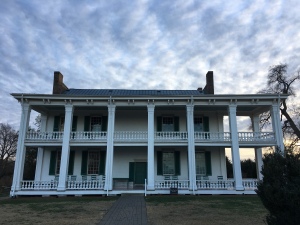
The McGavock’s Carnton Plantation
From the Lotz House, we rushed over to the McGavock Plantation at Carnton, one of many houses used as a hospital for Confederate soldiers. This was the site we especially wanted to see, as it was the setting of The Widow of the South. It truly did not disappoint! The McGavock plantation is huge and lovely. While the owner after the McGavocks sanded off the bloodstains on the bottom floor because they bothered his daughter (understandably!), he did leave the stains on the second floor. These are by the windows on the South side, so doctors were able to utilize the light. Additional tables were set up in the yard to continue to operate.
When you realize the Battle of Franklin left 10 wounded men per citizen, one can understand how every house in town became a hospital What made the McGavock farm different is the family themselves. Our tour guide quoted an eye witness who recounted seeing Carrie McGavock sitting on the stairs writing a letter for a wounded soldier who knew he was going to die. Carrie’s described as having most of her overslip torn away for bandages, and her sleeves and skirt about 3/4 coated in blood. The McGavocks were offered the opportunity to leave or to sequester themselves in one room on the second floor. Instead of running or hiding, the McGavocks jumped in to help out, even with their young children.

The McGavock Family Cemetery
But, the McGavocks involvement didn’t end with just offering their house as a hospital for months. They also donated a portion of their land, next to their own cemetery containing both the McGavock’s and the McGavock slaves, to provide a cemetery for Confederate soldiers who had been buried shallowly on the battlefield, then washed up in a torrential rain. While they had help cataloging the bodies, which are arranged by state, they also spent the rest of their lives answering letters from relatives who thought their men were here and caring for those relatives when they visited the graves. Carrie McGavock also mourned these men as her own three children who had died young as she daily walked through the cemetery.
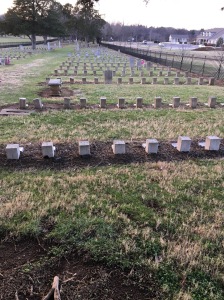
One side of the Confederate Cemetery
Though our feet were killing (3 one hour tours, and one 90 minute tour), we thoroughly enjoyed our experience and hope to return in warmer weather.
August 4, 2017
A Receptive Welcome to Fort LeBoeuf
Posted by amybrailey under Battlefield, Export, French Indian War, George Washington, Native American, Pennsylvania, Travel | Tags: Fort LeBeouf, George Washington, Governor Dinwiddie, History, Travel, Waterford, Writing |Leave a Comment
Because the Fort LeBoeuf Museum is only open Thursdays, Saturdays, and Sundays, I decided to make the almost three hour drive this morning (8/3/17). It was definitely an experience I’m glad to have had, though I wouldn’t drive that far for it again.
I pulled up to the Museum to be greeted my two teen boys (7th graders, I would discover.) When I asked if they worked there (because they had greeted me immediately), they informed me that they were part of the historical society there. I was truly thrilled to see these young men at work. They were composed, well-spoken, polite, and actually knew a few things about the museum. While they are still learning, (They told me a uniform was original–it had machine stitching on it–not from the 1700’s…) but overall, they were able to point out some cool things in the museum, and we discussed many of them. Their favorite was a model of how pelts were pressed into packs. It is, however, a very small museum, though free–which is a perk. Still, they did have a number of cool replica uniforms, which will be very helpful as I write.
Another cool thing was the map of where Washington traveled, going from Williamsburg to Fort LeBoeuf to deliver the letter telling the French to leave. (Again, this is 450 miles one way! On boat, foot, or horseback!) When the distance for me was trying, I can’t imagine the trip they took–in December, no less.
The couple who founded the museum were incredibly kind and helpful. Joan took me behind the museum to show me where the fort had been and demonstrate why they had chosen this spot. It seems even at this time, there was an understanding of the importance of the high ground. This fort rested on a bluff overlooking French Creek (a river), which would have been a strategic spot on the waterways, which were the super highways of the day.
Additionally, across the street from the museum is the only statue of Washington wearing a British uniform.
Still, at the end, I felt a bit like Washington when he had to this fort to deliver Governor Dinwiddie’s letter telling the French to leave the area because they were on British lands. I had gone a far distance without much to show for it (but, at least I didn’t get shot at on my way out of town like he did–for that, I am grateful.)
So, this concludes my study of Washington for this trip. I’ve traveled almost 6,000 miles, met a number of amazing people, and learned so much more than I knew before. I’m incredibly grateful to the Individual Artists Grant for allowing me this opportunity!
August 4, 2017
Guns, Guts, and Glory: A visit to Fort Ligonier and the Braddock’s Battlefield History Center
Posted by amybrailey under Battlefield, Export, French Indian War, George Washington, Native American, Pennsylvania, Travel | Tags: 7 Years' War, Anna Ivanovna, Battle of Monongahela, Benjamin Franklin, Braddock's Battlefield History Center, Forbes, Fort Ligonier, General Edward Braddock, George Washington, History, Travel, War of Austrian Succession |[4] Comments
Having visited Fort Necessity yesterday, I was almost blown away when I visited Fort Ligonier today (8/2/17). The expanse of the fort absolutely blew me away. But the fort itself is not all that is impressive at Fort Ligonier.
When I first entered the Museum, I was honestly disappointed–the museum covers the 7 Years’ War (The International Conflict which the French Indian War contributed to) starting with the War of Austrian Succession for back story. I have gotten to the place of such a specific focus that I was especially looking for new information on that section. Once I got past the “This wasn’t what I was expecting” feelings, I started to actually look at the exhibits. I was completely blown away by the artifacts they have. They host a case dedicated to each country involved in the 7 Years’ War, complete with uniforms, weapons, and a host of other artifacts. How a museum in Pennsylvania acquired such amazing artifacts from Asia, Africa, and all over Europe and the colonies, I’ll never know, but the collection is one of the finest I’ve seen.
Additionally, they currently have a rare collection of Washington artifacts (with more exhibits promised to come). The current collection includes his dueling pistols (given to him by the Marquis de Lafayette) and his handwritten remarks (originals) about the French Indian War. It also has a gallery of art about the French Indian War and the original parlor of St. Clair. I’m excited to see all the changes they bring.
Fort Ligonier also offers a variety of activities for kids. Today was cannonball club–children got in Free. And on the first Friday of the month in the summer months, everyone is free (Friendly Fire Fridays). I chose to pay to come today to a.) miss the crowd and b.) not have to hike around in the rain (predicted for Friday). But, this definitely seems to be a place that offers a ton of activities for kids (The lobby has children’s writings and projects about the fort on display!)
Outside the museum, the fort is incredibly impressive. This was the last fort along Forbes road as he was preparing to assault Fort Duquesne (and pick up the pieces after Braddock’s miserable defeat.) Still, the amount of buildings was incredible! There were barracks, officers quarters, quarter masters, hospital areas, a cellar for gunpowder complete with a ladder you have to climb down to get in–all designed from two original maps of the fort telling precisely what went where. There’s also an additional officers’ quarters not on the map, but the archaeological evidence indicates both the foundation and the use of the building.
My favorite part of the fort was the officers quarters where Washington stayed with two other officers. In it, there is a sign which tells of an incident I had read described by another soldier in a first hand account. Washington was bringing his men to support some Virginians under attack. Because it was dusk, the troops they were going to reinforce fired on them, and Washington’s men fired back.
Washington rode down the middle of the two groups, pushing guns aside, and yelling at the men not to fire. In the first hand account I heard, it stated that the man was terrified because Washington was right in the middle of the two armies when the volley rang out. But, when the smoke cleared, George was still standing (riding, actually), though he later writes that the encounter had placed his life “in as much jeopardy as it had ever been before or since.” But, that’s not the only time a bullet would miss Washington. (I later learned that after he had delivered Governor Dinwiddie’s letter demanding the French leave and been rejected, as Washington was walking the 450 miles back to Williamsburg, one of his Indian guides who had been turned by the French at Ft. LeBoeuf took a shot at him, narrowly missing him. Washington and Christopher Gist chased him, but he got away.)
I left Fort Ligonier to head to the Braddock Battlefield History Center. I had learned from another website that there were very few reminders of the battle I wanted to cover, but this museum was one. It’s open Tuesdays, Wednesdays, Saturdays, and Sundays from 12-4 or by appointment. Interesting hours, but the man who started it 20 years ago is a wealth of information and worth any drive!
The area itself made me sad. It reminded me of Gary, back home in Indiana–an area once thriving and cultural because of the steel mills and now boarded up and passed over. I understand why the museum creator Robert T. Messner wanted to build a museum on the forgotten battlefield where so much history took place.
The Museum offers an hour video, which seems like a lot, but is so informative, it’s absolutely worth it. Then, the Mr. Messner sat with me for another hour and explained the entire background of the battle. His Museum also includes over 250 artifacts and 50 paintings or works of art (including ones he doesn’t like for their inaccuracies, but he is committed to displaying the art about the battle–even the bad art.) He also focuses on the role the Native Americans played in this battle, which by casualties inflicted was the second most important Native American battle–The defeat of St. Claire (of my Fort Ligonier visit fame) being number 1 and Custer’s Last Stand being a less noteworthy 10. He pointed out that when the French Commander was shot in one of the early volleys of the battle, it threw the French into a state of confusion but released the Native Americans from any responsibility to leadership, so they were free to fight the battle the way they wanted–with disastrous effect.
They flanked Braddock’s line and poured into them, specifically targeting officers and drummer boys. Casualties among the army are around 70%, while casualties among the officers are around 90%. That Washington made it out alive is miraculous!
Mr. Messner defends Braddock, however, despite the fact that he disregarded and alienated Native tribes and ignored Washington’s advice that a huge group of red coats was a giant target. Washington had fought Indians before. Braddock had not. But, Messner points out that the British made battle plans expecting the land in America to be the same as it was in Britain. So, when they say, “March from here to here,” they’re not considering that he has to fell trees and actually build a road to go over the Appalachians! Add to that the fact that his troops consist of every other regiment’s cast offs (Seriously, would you send him your best soldiers?), and to get any money for his engagements, he has to go through the Pennsylvania Assembly instead of the crown–an Assembly made up largely of Quakers who don’t believe in fighting in the first place. I see his points.
Additionally, he points out (as will Washington) the cruelty of timing. Most of the Indian tribes were from Wisconsin, Michigan, and Ontario–it took them a while to get there and they weren’t going to stay forever. The fact that Braddock had taken a month to train his men instead of marching straight to Ft. Duquesne means he met the Indians who had arrived two weeks previously. Had he trained longer, the Indians would have left–as they did at Fort Necessity facilitating the parlay. Brutal timing.
Three other things stood out from my discussion with Mr. Messner. First, he has a painting which shows Benjamin Franklin talking to General Braddock (The original hangs in the library down the street from the Museum.) Apparently, Benjamin Franklin tried to warn Braddock not to fight in lines and that the Native Americans would decimate them. But, Braddock scoffs and says essentially that maybe they could defeat the Colonials, but they held no threat to the British Army. How wrong he was! This understanding that the British had no idea how to fight on American soil planted the seeds that they could possibly be overcome when we decide to take them on ourselves.
The second thing that stood out was he mentioned that Monongahela was Washington’s last major engagement before he is named commander-in-chief 20 years later. That’s when it struck me–he wore his uniform to the Continental Congress 20 Years Later! The uniform he wore as a 20 year old, still fit him as a 40 year old! (Though Messner points out he looks a bit chubby in the painting…) Still, how many people can fit into clothes they wore 20 years ago.
The final point of interest at the museum is another of what I call “Histories Mysteries.” In a box buried shallowly on the battlefield is found rings, coins, and a medal from Russian Empress Anna Ivanovna. The speculation is that the box belonged to a surgeon and the contents were things taken from bodies. But, why a Russian medal from an incredibly unpopular Russian leader? Definitely a mystery!
All in all, it was a fascinating day and two places I definitely recommend!
August 2, 2017
The Agony of Defeat: Fort Necessity and Braddock’s Grave
Posted by amybrailey under Battlefield, Export, French Indian War, George Washington, Nature, Pennsylvania, Photography, Travel, Uncategorized | Tags: Battle of Monongahela, Fort Duquesne, Fort Necessity, French Indian War, General Edward Braddock, George Washington, Governor Dinwiddie, Grave, History, Joseph Coulon de Villiers, Louis Coulon de Villiers, Native Americans, Nature, Photography, Tanacharison, Theories, Travel, Writing |[2] Comments
I was excited to head to Fort Necessity today (8/1/17) because this is where it all began: The French Indian War which gave rise to the American Revolution. So much of Washington is tied up in this area–his worst defeat, his biggest betrayal, his deepest humiliation, and the loss of a surrogate father figure. Standing on the ground here, I felt, would give me the greatest insight for my book. It is a truly incredible place.
I hadn’t realized that Washington and his men had spent almost two months clearing land for a road to attack Fort Duquesne. One thing that has always stood out to me in this area is just how many trees there are–everywhere. I can’t imagine trying to carve a path through them, much less fighting in them. When he happened upon the Great Meadows, it must have seemed an oasis in the desert. He termed it, “A charming field for an engagement.” For a man who desperately wanted a British commission and who had been trained in the shoulder to shoulder British style of fighting, this spot was perfect. Still, he hadn’t intended it for military service, but merely a supply station for troops attacking Fort Duquesne.
That all changed when three days later, Washington’s ally Tanacharison (the Half King) informed Washington there were French in the area (about 7 miles away). His actions later make me wonder if this was a set-up, and he was simply using Washington. Washington and 40 men set out to the Half King’s camp. When they arrive, his scouts lead them to a ravine where the French are encamped. From this point, two different versions of the story come into place. Like typical siblings, both the French and the British claim the other one started it. The French claim the British surprised them, and they fired back. The British claim the French saw them approaching and fired first, with the British return fire being self defense. Whatever actually happened, at the end of the day, the French commander Joseph Coulon de Villiers (Sieur de Jumonville) and 9 others were killed, one wounded, 21 prisoners, and one man who escaped to carry the news to Fort Duquesne. British casualties were one killed, two wounded. This would lead me to believe the British fired first, though they did have the high ground, so the disparity in casualties could come from that. The interesting thing is that Coulon de Villiers was actually only wounded and was possibly trying to surrender–until the Half King got ahold of him–literally. With a tomahawk.
When British Colonel Fry falls off his horse and dies of his injuries two days later, Washington is promoted to Colonel. With the weight of leadership on his shoulders and the expectation of French retaliation from Fort Duqesne, Washington begins to try to make the area a fort, while still trying to do work on the road. He has men guard those working on the road, but even with reinforcements still only has about 400 men. His Indian allies meet with him, but when they realize Washington’s supplies haven’t come through as promised, and he has barely enough provisions for his men, they decide the British are a lost cause and refuse to fight. Thus, Washington will face the 700 approaching Frenchmen and Indians with no allies. I’m sure this was a huge betrayal by those he thought would stand with him–especially the man who was actually to blame for the incident. But, it’s about to get a whole lot worse.
It’s a horrible, rainy day on July 3, making fighting sporadic, as both sides are dealing with wet gunpowder, and Washington’s men are standing in trenches, which are slowly filling up. The commander of the French Army is none other than the Louis, brother of Joseph Coulon de Villiers. But, Providence will both save Washington and humiliate him. The Indians with the French prefer the element of surprise and the spoils of war. Seeing that there is neither at this time, they tell Louis Coulon De Villiers that they will leave in the morning. He has a choice to make.
He requests a truce to parlay, offering Washington the chance to surrender. But, when the terms are sent to Washington, they are smudged because of the rain. Washington’s normal translator had been killed, and the man who was translating was Dutch, but could understand most of what was said. Most being the key word. He informs Washington that the terms are generous, allowing Washington and his men to leave with honors of war, taking their baggage and weapons (but no swivel guns–like little cannons) and return immediately to Virginia. They had to leave two men as hostages (who would volunteer, then provide valuable intelligence as spies.) Unfortunately, the translator left out the part where, by signing, Washington is admitting to the assassination of Joseph Coulon de Villiers, whom the French claim was acting as an ambassador, in the same role as Washington himself–though papers in his effects give the possibility he was spying as well (as the British would claim). This report makes it all over Europe and the colonies, and Washington is humiliated. Though Governor Dinwiddie doesn’t blame Washington when he reaches Virginia, he will disband the Virginia regiments into garrison companies, and will offer Washington the demoted rank of Captain. When Washington is unable to negotiate a higher rank, he will leave military service less than three months after the Fort Necessity debacle and return to Mount Vernon.
But, Washington doesn’t get too comfortable in the quiet life as a farmer. When General Braddock is named Commander in chief of the British forces and arrives in America with two Irish regiments, Washington sends him a note of congratulations–a great way to get noticed. Because of the way British commissions worked, Washington would be subordinate to even his British inferiors, so he makes the decision to accept the offer to join as Braddock’s Aide de Camp–a volunteer position in which he only answered to Braddock, and he could pave the way to a commissioned rank.
I can’t imagine what he must have felt when his path led him back to Fort Necessity, where the bones of his men were still visible against the landscape (the French had burned Fort Necessity to the ground.) But, he had another chance to assault Fort Duquesne. Unfortunately, it would be another devastating loss.
Braddock has mostly heeded Washington’s advice on the advance. He has men scouting and protecting the flanks and rear as the army crosses the Monongahela River. When he doesn’t get ambushed, however, Braddock assumes the French are holed up in the fort and pulls the scouts in, lining his men up, unfurling the banners, and striking up the band. There’s not a chance the French can miss their arrival. Unfortunately. Unbeknownst to him, the French know Braddock’s coming and had made the decision to surprise attack–they just didn’t make it to the river in time. The two armies slam into each other. And though the British have over twice the numbers, the French and Indians are fighting ambush style, hitting the flanks from the treeline, and the British lines literally collapse into each other, forming a mass of red coated men–a horribly easy target. Washington and Braddock, both on horseback, are trying to return order to the situation. Both have horses shot from under them. Both have bullet holes in their clothing. Both are unhit–until Braddock is struck with a bullet to the shoulder which passes into his chest. Washington is able to get him into a wagon and off the field, then assemble the men and cover the retreat.
Unfortunately, Braddock, who had been a sort of father figure to 24 year old George who had lost his own father at 11, would die three days later. Washington himself will preside over the burial, choosing to bury him in the road he had built where soldiers will march over his grave, obscuring the site from those who would seek to desecrate the body. He will remain there until 1804 when men repairing this section of the road will stumble upon the remains and move them to the hill.
Ironically, this site of so much pain will be bought by Washington who visited after the war. For the surveyor, it is indeed a beautiful piece of land, but I can’t imagine being able to see past all the memories he would have had. But, knowing that he also revisited Valley Forge, I believe Washington didn’t shy away from the hard places. Perhaps that’s another thing that makes him great.
August 1, 2017
Conquering Fort Pitt: Almost as difficult as 1758.
Posted by amybrailey under Battlefield, Export, French Indian War, George Washington, Native American, Pennsylvania, Travel | Tags: Blockhouse, Culture, Fort Duquesne, Fort Pitt Museum, French Indian War, History, Native American, Pittsburgh, Travel, White Eyes |Leave a Comment
When I set off today (7/31/17) for Pittsburgh, I had plans to visit Fort Pitt and explore some of the surrounding areas. I had forgotten (blocked?) just how much I hate cities. Don’t get me wrong–some of the coolest things to see are inside cities, but the hassle of getting there always has me frustrated before I arrive wherever I’m going. Fort Pitt was my normal annoyance on steroids.
To the best of my memory, I haven’t been to Pittsburgh before, and the internet analysis of traffic was truthful, but not positive. I was relying on my GPS to locate Fort Pitt (having identified its location on a map), and it didn’t steer me wrong–sort of. It did, in fact, identify Fort Pitt. While I was on a bridge. And the building was about 20 feet below me. With no indication of a road down. Consequently, I spent an hour and a half driving back and forth over the bridge and surrounding areas trying to figure out where to actually park to approach Fort Pitt. I had googled Parking Garages in the vicinity, but they seemed miles from the actual building. I strongly considered calling it a day and driving back home. I’m glad I didn’t.
To save you the hassle, I will share my wisdom, so you can do better (or at least faster) if you visit. I chose a parking garage at the corner of Fort Duquesne and Stanwix. It costs $20 for the day (Advertised $6.00–but after 4. Read the fine print.) There is another garage for $13 a day at Fort Duquesne and Sixth Street (which I was headed to when I found this one.) It’s a better deal, but 2+ blocks farther away. After you park, walk down Fort Duquesne until you can turn left on Commonwealth Place. As you turn, you’ll see a park area in front of you with a circling walkway that goes under the bridge (and over a little bridge of its own). Take the pathway, and you come out at the Fort Pitt Museum.
Once I actually arrived, I thoroughly enjoyed visiting the museum. The first floor contains a model of Fort Pitt and vicinity, a gallery of paintings about the French Indian War, and many free standing scenes including traders, barracks, Native American scenes, and the model of the inside of the block house. There is a lot of reading on panels here, but they explain a great deal about the war.

Depiction of the British articles of war
The main exhibits, however, are on the second floor. One thing I especially appreciated was the separation of French, British, and American. Each topic, whether it was uniforms and weapons, reasons for fighting, or responses to various circumstances, contained the views of each side. I was struck once again with how complex war often is. I have always presented the Civil War as a many layered event with people fighting for a variety of reasons, but it seems the French Indian War was the same. I suppose that’s true in every conflict–people have different reasons why they do what they do. I was also struck with how many times people made stupid and hurtful choices trying to get revenge–Like the whole congregation (96+ people) of Moravian Christian Indians who were slaughtered (after being told they’d be executed and spending the night singing hymns) simply because the soldiers wanted revenge against an entirely different group of Native Americans. There’s also the time two soldiers decided to kill White Eyes–the spokesman of the Delaware who was known as “The Peacemaker” for his work negotiating treaties. Of all the people you’d think to kill, the leader who was on your side shouldn’t be at the top of that list!
I also read about the commander who chose tho deliver two smallpox infested blankets and a handkerchief to the Native Americans even before his commanding officer commanded him to do just that. It was an intentional biological attack. The museum sites case after case where the Native Americans are stuck in the middle, trying to decide who to trust: the British or the French, then the British or the Americans. The choices are not great.
I finished up at the Museum, getting a detailed book on the campaign during which my book is set, and headed outside. There is a remaining block house outside of the museum, but it’s only open Wednesdays through Sunday April through October and weekends the rest of the year, so I didn’t get to go inside. This blockhouse is one of the original 5 redoubts placed on the perimeter of Fort Pitt for added security. It is the only remaining part of the Fort. There is also an outline of the location where Fort Duquesne stood.
All in all, it was a very informative day, but I’m looking forward to the forts that are a little more easily accessible–and a bit more off the beaten path!
July 31, 2017
Flights of Angels: The Flight 93 Memorial
Posted by amybrailey under Export, Pennsylvania, Photography, Travel, Washington D.C, White House | Tags: 9-11, Family, Flight 93, History, Memorial, National Park, Pennsylvania, Photography, Shanksville, Travel |Leave a Comment
Every American remembers where he or she was on September 11, 2001, when they got the news (if they were old enough to be aware of their surroundings.) I was teaching at a small private school at the time, and it was right before our 10:00 break when the school secretary knocked on my classroom door. I stepped into the hallway to find her white faced and tear stained. “Amy, they’ve hit the White House and the Pentagon. We’re at war.” No explanation on who and misinformation on events, but the pit of my stomach dropped as I had to turn back, wide-eyed, to face a room full of teenagers blissfully unaware of what had happened. My dad had done briefings at the Pentagon. How could this happen?
When the bell rang for our break, we rushed en masse into the computer lab and began frantically googling. The rest of a school day was a blur–I remember the conversations about whether or not to cancel (We chose no–terrorists will not disrupt our schedule. Their goal is to make us afraid. We run away, we let them win.), the phone calls saying to get gas on the way home as it might go up to $5.00 (I got it at $1.81–almost 2 times our norm–the station down the road was up to $3.15.), and the wondering of just what had happened.
I went home and watched the news for eight hours straight, running back and forth between my rooms and the family I lived with, swapping stories and recommending channels. I remember how we waited for them to find survivors, hoping and praying. How patriotic everyone was, and how eerily quiet the skies were for the next several days then how weird a plane looked when they finally started flying again. I remember President Bush’s speeches, one heard standing in a room full of enlisted men when he announces our intention to fight back, and they all cheered. I swelled with pride at flags hung over buildings and off of equipment, awed by the tireless service of men and women who poured from across the country to help, yet I also felt the sorrow of unimaginable loss–mothers, fathers, husbands, wives, children.
In the focus on the Twin Towers and the Pentagon, especially trying to find survivors, Flight 93 kind of got passed over. We mentioned they had fought back and probably saved the White House or the Capital, and Todd Beamer’s “Let’s Roll” became well known, but mostly, they weren’t the main focus. So, when I drove into Western Pennsylvania and passed the sign, I felt drawn to find out more.
Today (7/30/17), a dear friend who had gone to the Memorial on Friday when it had been packed wanted to revisit, so we went, though it isn’t anything to do with my grant or George Washington. Yet, since he also chose to fight back–even against insurmountable odds–I think I can still learn something.
The Museum itself is incredible. Displays contained in-depth information on the passengers, their personal effects, final actions, and lives. I was riveted by the display that gave transcripts of the cockpit conversations, showing the flight path as the struggle took place. I had no idea the terrorists had rocked the plane back and forth in an effort to stop the passengers’ assault. Nor did I realize how many phone calls were made and that the decision to fight back seems to have been unanimous with three passengers even ending phone calls to be part of the attack. Additionally, I was unaware that the passengers waited to do their attack until they were over a rural area to minimize damage if they were unsuccessful. Listening to the phone calls left on answering machines, we were struck with how calm these ladies were, usually until the very end. One even minimized the situation (“We’re having a bit of trouble on the plane. I’m fine for now…”)
Because of their foresight, FBI agents quickly realized this site would yield the most information, since there was no debris mixed in with the plane remains–a thought that never occurred to me about the other buildings. This site is the only one where both the cockpit voice recorder (only one) and the flight recorder (one of two) were both recovered. You can read the transcripts of the events and voices, but they don’t have the audio available. But, reading the transcripts while watching the flight simulator is a truly awe-ful (in both senses) experience. Additionally, they recovered one of the terrorists’ credit cards and handwritten plans/instructions–I can’t imagine how these survived the inferno of a 535 mph impact with 5,000 gallons of jet fuel. But, this card was the key to tracing the money trail. There were so many fascinating things to see! My other favorite stop was being able to get a short biography of each passenger, what effects of theirs were found, and what tributes have been made in their honor. Two of the most amazing effects to survive (to me) were a man’s NIV Bible inscribed with his name and a woman’s prayer card from her husband’s memorial service. I’m so glad each person was honored. We wondered how many visitors who we encountered had loved ones or friends on that wall.
After looking through the Museum, we headed down the approximately one mile meandering walk out to the crash site. Since it is a burial ground, you cannot walk directly out to the spot, but a large boulder indicates where it is. Additionally, there is a wall of names and niches along the walkway where visitors can leave tributes. It’s a beautiful walk filled with wildflowers against a mountain vista–stark contrast to the horror which happened here, and yet another reminder of beauty from ashes and bravery and honor in the face of terror and evil.
It’s a poignant reminder that, as one visitor summarized Edmund Burke’s statement, “‘The only thing necessary for evil to triumph is for good men to do nothing.’ You didn’t ‘do nothing,’ and so evil didn’t triumph.” May we take from this example the courage to stand against evil wherever it lurks and do what we can to fight it!
July 29, 2017
The Beginning of Honor
Posted by amybrailey under Civil War, Export, French Indian War, George Washington, Maryland, Travel | Tags: Citizens honor, Maryland State Parks, Rainy day, Travel, Washington's Monument |Leave a Comment
I spent today (7/28/17) visiting dear friends who live in the Harper’s Ferry area. I have eased back into my second week of my grant, and had wanted to head back to the Winchester area to see if there was anything else I needed to see. However, the rainy day was a damper on plans to explore some other areas. Still, my friend suggested we explore the Washington Monument, so we headed over to Washington Monument State Park in Middletown, Maryland.
This hidden treasure is the first monument to Washington, erected by the people of Boonsboro, Maryland, on July 4, 1827. At the end of the day, they had stacked stones to create a 15 foot monument on a 54 foot base. (It was later raised to 30 feet.). They read the Declaration of Independence, and the monument received a gun salute by veterans of the Revolutionary War. While the monument did fall into disrepair over time, it was used as a signal tower by the Union army during the Civil War and was preserved and restored by the CCC (Civilian Conservation Corps) in 1936.
The ranger at the Museum explained that this area loved George Washington, who had crossed many times through surveying and the French-Indian War. He explained that Route 40 was actually George Washington’s idea (pushed through Congress by Jefferson) for the National Road because he’d been travelling the Indian trails through here so much. So, though I wasn’t expecting to literally “walk where Washington did,” I had the experience of seeing his trails and the simple way he was honored by the people of a small town who had loved him. It was a blessing indeed.











